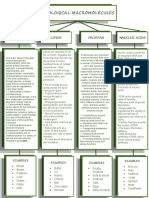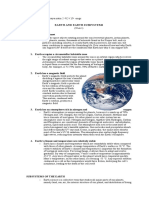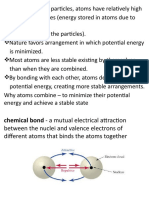0 ratings0% found this document useful (0 votes)
215 viewsQuiz 1 - Macromolecules
Quiz 1 - Macromolecules
Uploaded by
Mariano Valiente Jr.1) Hydrolysis is the breaking of a long-chain compound into its subunits by adding water molecules to its structure between the subunits.
2) A dehydration reaction typically produces polymers by forming large molecules from small repeating units.
3) Macromolecules are composed of smaller repeating units called monomers that are linked together.
Copyright:
© All Rights Reserved
Available Formats
Download as DOC, PDF, TXT or read online from Scribd
Quiz 1 - Macromolecules
Quiz 1 - Macromolecules
Uploaded by
Mariano Valiente Jr.0 ratings0% found this document useful (0 votes)
215 views3 pages1) Hydrolysis is the breaking of a long-chain compound into its subunits by adding water molecules to its structure between the subunits.
2) A dehydration reaction typically produces polymers by forming large molecules from small repeating units.
3) Macromolecules are composed of smaller repeating units called monomers that are linked together.
Original Description:
Macromolecules
Original Title
Quiz 1 -- Macromolecules
Copyright
© © All Rights Reserved
Available Formats
DOC, PDF, TXT or read online from Scribd
Share this document
Did you find this document useful?
Is this content inappropriate?
1) Hydrolysis is the breaking of a long-chain compound into its subunits by adding water molecules to its structure between the subunits.
2) A dehydration reaction typically produces polymers by forming large molecules from small repeating units.
3) Macromolecules are composed of smaller repeating units called monomers that are linked together.
Copyright:
© All Rights Reserved
Available Formats
Download as DOC, PDF, TXT or read online from Scribd
Download as doc, pdf, or txt
0 ratings0% found this document useful (0 votes)
215 views3 pagesQuiz 1 - Macromolecules
Quiz 1 - Macromolecules
Uploaded by
Mariano Valiente Jr.1) Hydrolysis is the breaking of a long-chain compound into its subunits by adding water molecules to its structure between the subunits.
2) A dehydration reaction typically produces polymers by forming large molecules from small repeating units.
3) Macromolecules are composed of smaller repeating units called monomers that are linked together.
Copyright:
© All Rights Reserved
Available Formats
Download as DOC, PDF, TXT or read online from Scribd
Download as doc, pdf, or txt
You are on page 1of 3
Macromolecules Structure and Function -- Block 1, 2005 -- Name:
__ 1. Hydrolysis could be correctly described as the
a) heating of a compound to drive off its excess water and concentrate its volume
b) breaking of a long-chain compound into its subunits by adding water molecules to its
structure between the subunits
c) linking of two or more molecules by the removal of one or more water molecule
d) constant removal of hydrogen atoms from the surface of a carbohydrate
e) none of the above
__ 2. The formation of large molecules from small repeating units is accomplished by a(n)
______ reaction.
a) oxidation c) dehydration e) decarboxylation
b) reduction d) hydrolysis
__ 3. A dehydration reaction typically produces:
a) monomers b) salts c) sugars d) polymers e) amino acids
__ 4. A macromolecule is composed of smaller units called:
a) polymers b) cells c) isomers d) monomers e) isotopes
__ 5. Which of the following is not a macromolecule?
a) protein b) starch c) nucleotide d) lipid e) DNA
__ 6. A(n) ____________ is a basic unit of a carbohydrate.
a) monosaccharide c) nucleotide e) amino acids
b) starch d) glycerol
__ 7. Which of the following includes all the others?
a) sucrose b) glucose c) cellulose d) glycogen e) carbohydrate
__ 8. Which of the following is not a monosaccharide?
a) glucose b) fructose c) deoxyribose d) starch e) ribose
__ 9. ORGANIC COMPOUNDS that are composed of carbon, hydrogen, and oxygen in a 1:2:1
ratio are called:
a) proteins b) nucleotides c) sugars d) fatty acids e) nucleic acids
__ 10. STARCH and CELLULOSE are ALIKE in that both are:
a) composed of covalently bonded glucose molecules
b) found only in animal cells
c) contain sugars bonded together in identical ways
d) contain non-polar, fatty acid side chains
e) made up of sugars that contain carbon, hydrogen, oxygen, and nitrogen
__ 11. A CARBOHYDRATE (polysaccharide) that makes PLANT CELLS and tissues
STRUCTURALLY RIGID is:
a) sucrose b) glycogen c) starch d) cellulose e) nucleotides
__ 12. A carbohydrate (polysaccharide) that is formed by plants and used later by the plant as a
reserve food supply and made up of only glucose molecules covalently bonded together is:
a) cellulose b) starch c) glycogen d) triglycerides e) sucrose
__ 13. In a lipid bilayer ___________ tails point inward and form a region that excludes water.
a) acidic b) basic c) hydrophilic d) hydrophobic e) none of these
__ 14. Lipids
a) serve as food reserves in many organisms
b) include cartilage and chitin
c) include fats that are broken down into one fatty acid molecule and three glycerol
molecules
d) are composed of monosaccharides
e) none of the above
__ 15. What type of LIPIDS are found in ALL biological MEMBRANES?
a) triglycerides b) waxes c) phospholipids d) diglycerides e) cholesterol
__ 16. Unlike the saturated fatty acids, UNSATURATED FATTY ACIDS: are found mostly in animal
fats and oils
a) contain hydrogen, carbon, nitrogen, and oxygen
b) are often covalently bonded to sugars
c) lack of carboxyl group
d) contain double covalent bonds between carbons in their hydrocarbon chain.
__ 17. Amino acids are the building blocks for
a) proteins b) steroids c) lipids d) nucleic acids e) carbohydrates
__ 18. The sequence of amino acids is the ___________ structure of proteins.
a) primary b) secondary c) tertiary d) quaternary e) stereo
__ 19. Of the following functional groups, which one is known as the AMINO GROUP?
a) -SH b) -COOH c) -NH2 d) -OH e) -CHO
__ 20. Nucleotides are the building blocks for
a) proteins b) steroids c) lipids d) RNA e) carbohydrates
__ 21. Nucleotides are composed of a(an): A. AMINO ACID, B. NITROGEN-CONTAINING BASE,
C. FATTY ACID, D. 5-CARBON SUGAR, E. PHOSPHATE MOLECULE.
a) B, D, C b) A, D, E c) C, D, E d) B, D, E e) A, B, C.
__ 22. Nucleotides contain ___________ sugars.
a) three-carbon b) four-carbon c) five-carbon d) six-carbon e) seven-carbon
__ 23. DNA and RNA are examples of which FAMILY of BIOLOGICAL MOLECULES?
a) proteins; b) carbohydrates c) lipids d) amino acids e) nucleic acids
__ 24. Draw the structure of an amino acid.
You might also like
- Macromolecules in My Food ActivityDocument3 pagesMacromolecules in My Food Activityapi-323374257No ratings yet
- 7 Neutralization TitrationsDocument32 pages7 Neutralization TitrationsnidsNo ratings yet
- Quiz 1 - MacromoleculesDocument3 pagesQuiz 1 - MacromoleculesMariano Valiente Jr.No ratings yet
- Nucleic Acid WorksheetDocument3 pagesNucleic Acid WorksheetGermaineAmarantineTongNo ratings yet
- Macromolecules WorksheetDocument10 pagesMacromolecules WorksheetShaira BautistaNo ratings yet
- Macromolecules. Monomers: Bio 11O Topic 5 - BiomoleculesDocument8 pagesMacromolecules. Monomers: Bio 11O Topic 5 - BiomoleculesYda TolentinoNo ratings yet
- CHN Transes Midterm FRM TVCDocument18 pagesCHN Transes Midterm FRM TVCmamsh KlangNo ratings yet
- Chemical Kinetics: Collision Theory of Reaction Rate: Emmanuel NtambiDocument21 pagesChemical Kinetics: Collision Theory of Reaction Rate: Emmanuel NtambiMoses Umaru MwesigwaNo ratings yet
- Physical Science Week 4Document11 pagesPhysical Science Week 4Rona Grace MartinezNo ratings yet
- Biological Macromolecules: Nucleic Acids Proteins Carbohydrates LipidsDocument1 pageBiological Macromolecules: Nucleic Acids Proteins Carbohydrates LipidsJoan PamatNo ratings yet
- 5 4 Covalent BondingDocument34 pages5 4 Covalent Bondingapi-245709841No ratings yet
- Nervous System - Free Printable TestsDocument1 pageNervous System - Free Printable TestsRayan KassamNo ratings yet
- Animal Tissues: Joshua D. Marcial, MDDocument82 pagesAnimal Tissues: Joshua D. Marcial, MDChristine SegundoNo ratings yet
- Cells and Tissues: 2 Types of Cells That Are Found in The BodyDocument6 pagesCells and Tissues: 2 Types of Cells That Are Found in The BodyAngela ReyesNo ratings yet
- Polarity of MoleculesDocument14 pagesPolarity of MoleculesDenice De GuzmanNo ratings yet
- Earth Science Summative TestDocument4 pagesEarth Science Summative TestRoselle VictoriaNo ratings yet
- Unifying Themes in The Study of LifeDocument2 pagesUnifying Themes in The Study of LifeLiya Mae SantiagoNo ratings yet
- KIET PhysicsDocument82 pagesKIET Physicsap cpianNo ratings yet
- The Cell Cycle and Mitosis PDFDocument77 pagesThe Cell Cycle and Mitosis PDFRonzie EstrellaNo ratings yet
- IKIGAIDocument3 pagesIKIGAIAviyaan SrivastavaNo ratings yet
- Blood PPT NotesDocument7 pagesBlood PPT NotesArce JohnsonNo ratings yet
- Electronegativity: Classifying Bond Type: Return To Bonding MenuDocument2 pagesElectronegativity: Classifying Bond Type: Return To Bonding MenuSomshuvra BasuNo ratings yet
- Earth's Structure and System: LessonDocument40 pagesEarth's Structure and System: LessonGlen MillarNo ratings yet
- Review Well Hehe Kaya Natin 2 Earth and Earth Subsystems: Earth: The Living PlanetDocument29 pagesReview Well Hehe Kaya Natin 2 Earth and Earth Subsystems: Earth: The Living PlanetColeen CalalangNo ratings yet
- Lymphatic SystemDocument10 pagesLymphatic SystemxoxoNo ratings yet
- Lesson 2 Formation of Heavy ElementsDocument21 pagesLesson 2 Formation of Heavy Elementslily smithNo ratings yet
- Polar & Non Polar-ElectronegativityDocument23 pagesPolar & Non Polar-ElectronegativityAnonymous CHol1JCNOSNo ratings yet
- Physical Science Week 2 Lesson 1 4 1Document8 pagesPhysical Science Week 2 Lesson 1 4 1Marianne AbrinaNo ratings yet
- Seminar On Primary Health Care AND Primary Health Centre: Presented By: Ms. Neeta JimmichenDocument99 pagesSeminar On Primary Health Care AND Primary Health Centre: Presented By: Ms. Neeta JimmichenneetsjimmichenNo ratings yet
- Lymphatic PDFDocument8 pagesLymphatic PDFJoydee Liza MarcoNo ratings yet
- 1 - Integumentary SystemDocument36 pages1 - Integumentary Systemangelyn alfonsoNo ratings yet
- Daily Lesson LOG: School Grade Level Teacher Learning Area Teaching Dates and Time QuarterDocument5 pagesDaily Lesson LOG: School Grade Level Teacher Learning Area Teaching Dates and Time QuarterArlynn Arcaño IslaNo ratings yet
- Anaphy Special Senses NotesDocument6 pagesAnaphy Special Senses NotesThieza Mecca LucenaNo ratings yet
- Monosaccharides Formula Where Found: 4 QTR - Science The Chemistry of LifeDocument7 pagesMonosaccharides Formula Where Found: 4 QTR - Science The Chemistry of LifeJune Emerson ManalangNo ratings yet
- Cell Types and Cell ModificationDocument75 pagesCell Types and Cell ModificationAlaizaNo ratings yet
- Nuclear Reaction PDFDocument14 pagesNuclear Reaction PDFNafi IsmailNo ratings yet
- A-P Chapter 4 TissueDocument21 pagesA-P Chapter 4 TissueMONIQUE VELASCONo ratings yet
- Teaching Guide For MacromoleculesDocument5 pagesTeaching Guide For MacromoleculescarmenestuyaNo ratings yet
- Properties of BondsDocument36 pagesProperties of BondsPaulNo ratings yet
- Biological MacromoleculesDocument39 pagesBiological Macromoleculesapi-337296800No ratings yet
- CHN I Lecture Hand Outs WK 1Document28 pagesCHN I Lecture Hand Outs WK 1Bruno, Kurt Andrei V.No ratings yet
- Week 5-Earth-and-Life-ScienceDocument80 pagesWeek 5-Earth-and-Life-ScienceChaeyoung ParkNo ratings yet
- AtomsDocument27 pagesAtomsJannaNo ratings yet
- Mastery Test in DRR 2Document3 pagesMastery Test in DRR 2Juliville Hora SalinasNo ratings yet
- Eapp Lesson 1 Week 1Document20 pagesEapp Lesson 1 Week 1Guillermo AlvarezNo ratings yet
- PHYSICAL SCIENCE 2QpptDocument70 pagesPHYSICAL SCIENCE 2QpptCärl Jhelöü FernandezNo ratings yet
- CarbohydratesDocument35 pagesCarbohydratesRaincel Mae WarnacNo ratings yet
- From Cells To Organisms: Organisation of LifeDocument19 pagesFrom Cells To Organisms: Organisation of Lifeevrin drisNo ratings yet
- Rocks Type of StressDocument18 pagesRocks Type of Stressthatkidmarco22No ratings yet
- C 2 The Respiratory StructureDocument34 pagesC 2 The Respiratory StructurefadlinlinsaiNo ratings yet
- Chapter 10Document38 pagesChapter 10Glaiza MJ CamachoNo ratings yet
- Cell DivisionDocument28 pagesCell Divisionstan.suineg100% (1)
- Anph121lb CardiovascularDocument28 pagesAnph121lb CardiovascularDANIELA PEREZNo ratings yet
- Lesson Plan Week 3 FebruaryDocument8 pagesLesson Plan Week 3 FebruaryShe ShiNo ratings yet
- Biomolecules SCDocument64 pagesBiomolecules SCSwin EscobarNo ratings yet
- Cell Cycle & Cell DivisionDocument120 pagesCell Cycle & Cell DivisionGanesh Patil100% (1)
- Atoms WorksheetDocument6 pagesAtoms WorksheetAshley HughesNo ratings yet
- Genetic EngineeringDocument14 pagesGenetic EngineeringLyra BerkshireNo ratings yet
- Quiz 1 - MacromoleculesDocument2 pagesQuiz 1 - MacromoleculesIerdna RamosNo ratings yet
- Quiz 1 - MacromoleculesDocument2 pagesQuiz 1 - MacromoleculesRosielyn Fano CatubigNo ratings yet
- Bionanocomposites: Integrating Biological Processes for Bioinspired NanotechnologiesFrom EverandBionanocomposites: Integrating Biological Processes for Bioinspired NanotechnologiesCarole AiméNo ratings yet
- Requirements: Investigating The Chemistry of Group 2 ElementsDocument2 pagesRequirements: Investigating The Chemistry of Group 2 Elementssithlord95No ratings yet
- Ekc 336 Chemical Reaction Engineering: Reactor Design of Ethylene Oxide (Eo) ProductionDocument24 pagesEkc 336 Chemical Reaction Engineering: Reactor Design of Ethylene Oxide (Eo) ProductionYou Jin JieNo ratings yet
- International Journal of Biological MacromoleculesDocument9 pagesInternational Journal of Biological Macromoleculesfawole olaniyiNo ratings yet
- Class X Science Set 1 PDFDocument9 pagesClass X Science Set 1 PDFSahasra YeruvaNo ratings yet
- 401606-Aloa Confirmation EngDocument3 pages401606-Aloa Confirmation EngAndrei Bolocan0% (1)
- Electrochemistry: Exercise 1 Rusting of MetalDocument5 pagesElectrochemistry: Exercise 1 Rusting of MetalSansen Diamante Colipano Jr.No ratings yet
- 2012EC 2 Semester 3 Quarter Chemistry Worksheet For Grade 11. I. Choose The Best Answer From The Given AlternativesDocument5 pages2012EC 2 Semester 3 Quarter Chemistry Worksheet For Grade 11. I. Choose The Best Answer From The Given AlternativesPatrix ParkerNo ratings yet
- Purelink Rna Mini Kit QRCDocument4 pagesPurelink Rna Mini Kit QRCIsaac Nicholas NotorioNo ratings yet
- 5 Question Bank DRCDocument8 pages5 Question Bank DRCapi-297121029No ratings yet
- MCPADocument142 pagesMCPAThein Zaw MinNo ratings yet
- Aim, Problem Statement, HypothesiesDocument1 pageAim, Problem Statement, Hypothesieslh_mooNo ratings yet
- Polyester Based Hybrid Organic CoatingsDocument206 pagesPolyester Based Hybrid Organic CoatingsUsama AwadNo ratings yet
- Seliwanoff TestDocument14 pagesSeliwanoff TestImmanuel Lashley100% (1)
- (5167) Sheet Ionic Equilibrium Elementary Theory eDocument19 pages(5167) Sheet Ionic Equilibrium Elementary Theory eSunny MethaniNo ratings yet
- Hud Licky 1980Document3 pagesHud Licky 1980sharpiloalexeyNo ratings yet
- Acsomega 1c03586Document14 pagesAcsomega 1c03586Aqsa chNo ratings yet
- Antacid AnalysisDocument84 pagesAntacid AnalysisRajeswari Raji0% (1)
- Coordination Chemistry Structures and IsomersDocument272 pagesCoordination Chemistry Structures and Isomersد.حاتممرقهNo ratings yet
- Man Made Fibres Lecture PlanDocument4 pagesMan Made Fibres Lecture Planzulqarnain-rana-2024No ratings yet
- Metal Ammine Complexes 1928.Document296 pagesMetal Ammine Complexes 1928.Richard.nlNo ratings yet
- Lab 3 (Observing A Chemical Reaction) 2009Document5 pagesLab 3 (Observing A Chemical Reaction) 2009AnthonyMartinezNo ratings yet
- Sultamicillin Tablets 375 MG IHSDocument14 pagesSultamicillin Tablets 375 MG IHSGiancarlo Alessandro VettorNo ratings yet
- Biological Molecules OCR - The Science SauceDocument15 pagesBiological Molecules OCR - The Science SauceMunachi UdengwuNo ratings yet
- Research Papers On Xanthan GumDocument8 pagesResearch Papers On Xanthan Gumafedsxmai100% (1)
- Berea gl05 LabDocument7 pagesBerea gl05 LabGregorio Antonio Valero VerdeNo ratings yet
- June 2011 QP - Unit 3 Edexcel Chemistry A-LevelDocument16 pagesJune 2011 QP - Unit 3 Edexcel Chemistry A-LevelAssad JafferNo ratings yet
- Amberlite XAD1600 PDFDocument4 pagesAmberlite XAD1600 PDFAnonymous 6Nt20xK100% (1)
- Chemistry Paper 1Document64 pagesChemistry Paper 1Matty PNo ratings yet
- 10 1016@j Desal 2020 114643Document22 pages10 1016@j Desal 2020 114643VishnuShantanNo ratings yet

























































































